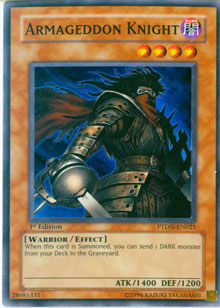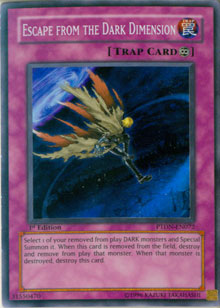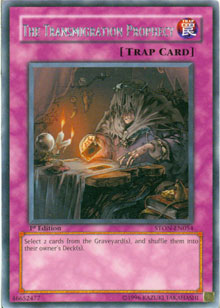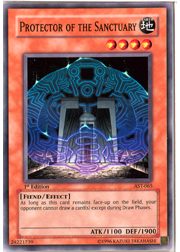After seeing the events of Shonen Jump Championship Costa Mesa firsthand, and then witnessing the general reaction to the coverage from the event, I have a slightly different take on the current format than some folks. I think everyone can agree that Dark Armed Dragon, on its own, is an exceptionally powerful and dangerous card. But at the same time, I don’t feel that it’s the number-one element responsible for Dark Armed Dragon Return’s success.
The deck commands a tremendous amount of speed, but the Dragon itself is not a fast card: it’s unsearchable, it has an awkward summoning requirement, and it’s relatively easy to disrupt through a variety of means. The deck can deal 8000 damage in a single turn, but unless you summon two of them, the Dragons aren’t responsible for even half of that output. In truth, the Dragon frequently isn’t even involved in the strategy’s victory. I think maybe we’ve all focused too much on the Dragon, and not nearly enough on the accompanying cards that have made it so fierce. Maybe decks like Oppression Gadgets aren’t succeeding as much as expected simply because they’re designed to outplay the wrong part of the Dark Armed Return strategy.
I gave that premise a lot of thought, and it naturally raised one question: if defeating the Dragon itself is the wrong thing to aim for, then what should a skilled duelist look to achieve? I came up with a lot of answers thinking about everything I saw in Costa Mesa, and today I want to discuss the best of the bunch.
Let’s talk about how to beat Dark Armed Return.

Hit Hard and Hit Early
If your opening move is to drop a face-up monster with 1400 ATK and pass, you deserve to take a pounding. Unfortunately, many of the decks developed to do away with Dark Armed Dragon are actually incapable of delivering big damage early. A Gadget deck might play a piece of monster removal and then attack for 1200 to 1400 damage—rather unimpressive. A combo deck like Exodia or Magical Explosion will usually draw a bunch of cards and then not attack, while Macro Cosmos might run over the Knight with D.D. Survivor or Banisher of the Radiance. Again, these are not high-impact maneuvers we’re talking about.
Many players will refuse to push on turn 1 at all, afraid that giving the opponent a second Dark monster in his or her graveyard could set off dire events next turn. An opponent packing the cards necessary to go off in that situation is likely to do so anyway, even if you left his or her Knight on the field.
Mark my words: if you can punish Dark Armed Dragon Return from turn 1 onward—even if the opponent goes first—you’ll have a much better chance of winning. The deck is largely being run in metagames where players are afraid of it, and that means they often refuse to act. That lets Dark Armed play to its own tempo, conserve as many cards as it wants, and generally have the run of the duel. That’s a mistake. The threat of Torrential Tribute and Mirror Force always looms in the eyes of an experienced duelist, but barring a strong read in that direction, it’s to your benefit to press hard and press fast.
Decks that can do so have an advantage in my mind. Zombies can flood the field on turn 1 with a half-decent draw, and can do it by turn 3 or so in most cases. Dark World actually commands the same capabilities, despite its reputation as a sub-par deck. Earth Rush has easy access to Injection Fairy Lily and Gigantes, the former of which was played successfully as a side-deck card in James Pennicott’s Oppression Burn in Costa Mesa. That concept alone might have been more successful than the rest of Pennicott’s main deck.
Cyber Dragon is severely underrated. It saw main-deck play in only four of the Top 32 decks from Costa Mesa, and even then, only seven copies were main decked (Germany’s Vittorio Wiktor ran only one). Want to wreck house on turn 1? You may not draw Cyber Dragon in your opening hand every single game now that it’s Semi-Limited, but packing a pair really ups your chances of a big opening turn.
Volcanic Monarchs can run Spirit of Flames, Water Control can use Aqua Spirit, and even some sort of Insect Beatdown could be developed around the new Aztekipede, the Worm Warrior. With stuff like Hand Destruction and Raigeki Break easily splashed into a lot of current deck types, speed isn’t as hard to achieve as most might think. It might come at the cost of a card here or there, but if it lets you win, it seems worthwhile.
Immobilize Return and Escape
 I honestly feel that Return from the Different Dimension and Dimension Fusion, along with seven "draw two card" effects, are the main reason behind Dark Armed’s domination. The Dragon means very little to this part of the deck’s strategy, as Strike Ninja, Prometheus, King of the Shadows, and Allure of Darkness usually remove more monsters from play than Dark Armed. Games are easily winnable without Dark Armed Dragon in this sense, and we saw just that situation time and time again in Costa Mesa.
I honestly feel that Return from the Different Dimension and Dimension Fusion, along with seven "draw two card" effects, are the main reason behind Dark Armed’s domination. The Dragon means very little to this part of the deck’s strategy, as Strike Ninja, Prometheus, King of the Shadows, and Allure of Darkness usually remove more monsters from play than Dark Armed. Games are easily winnable without Dark Armed Dragon in this sense, and we saw just that situation time and time again in Costa Mesa.
If you can shut down Return from the Different Dimension and Escape from the Dark Dimension on a reliable basis, then you cut a ton of power out of Dark Armed Return. Dark Magician of Chaos becomes a lot tougher to abuse, big win-turns largely depend on Dimension Fusion instead of the play-it-in-threes Return, and you start to get a lot of room to pressure your opponent. There are a lot of ways to do this, only a handful of which were seen at Costa Mesa.
You already heard this week from several of my compatriots here at Metagame.com just how good Dust Tornado can be. Matt Peddle discussed it yesterday in the context of Lazaro Bellido’s success at Costa Mesa, while Brian Bodkin lauded the card in his column on Thursday. I’ve been running it myself in Zombies, and being able to essentially steal would-be KO turns from my opponents is just astounding. Since Dark Magician of Chaos misses the timing for his spell recursion effect when Escape from the Dark Dimension is chained, it also makes a juicy target. Dust Tornado ties nicely into the aggressive strategy I proposed just paragraphs ago, stopping Mirror Force and Torrential Tribute if they’re in your way early on.
Beyond that, negation like Solemn Judgment or Dark Bribe can also stop a series of events that would otherwise lead to your defeat. We saw this at Costa Mesa, but it’s a trend that I expect to see grow over the coming weeks heading into Shonen Jump Championship Columbus.
So what else? How about Jinzo? Negating Return and Escape with the classic android is a great idea, because Dark Armed Return has very few outs to stop him. Sure, Dark Armed Dragon might be able to take him down, but if your opponent can’t abuse Escape to recycle Dark Magician of Chaos and draw more cards, he or she will have a hard time getting to the Dragon. Darklord Zerato has a devastating monster removal ability, but it’s usually being summoned from the removed-from-play pile, always with a trap card barring Dimension Fusion. Enemy Controller can make Jinzo easier to deal with, but I think it’ll take a while for duelists to accept Lazaro’s innovations and adopt that particular piece of tech.
Mobius the Frost Monarch is also exceptionally good, since the Dark Armed Return player often sets two cards to his or her back row (usually before the turn on which he or she plans to try and claim victory). While Escape can be chained against Mobius’s effect, it won’t lead to a free spell with Dark Magician of Chaos. That’s led some duelists to activate Escape in their opponent’s standby phase, which is about as poor as it sounds. Return from the Different Dimension is even worse, turning from a vicious game-ender into either a desperate shield or just a crumpled piece of cardboard for Mobius to stomp on.
Fact is, Dark Armed Return usually wins through Return or Dimension Fusion. While Dimension Fusion is tough to stop by conventional means, there are a lot of splash-able cards that can fit in almost any deck that can stop Return. Do that and you can buy yourself a surprising amount of time.
Manipulating the Graveyard
 The concept of offensive graveyard management in the Dark Armed matchup has become increasingly refined over the past few weeks. The previous goal of just depriving your opponent of three Darks in his or her graveyard has sort of fallen by the wayside, for two reasons: the opponent will dump more monsters there, and sending monsters out of play is just going to make Return and Dimension Fusion more effective.
The concept of offensive graveyard management in the Dark Armed matchup has become increasingly refined over the past few weeks. The previous goal of just depriving your opponent of three Darks in his or her graveyard has sort of fallen by the wayside, for two reasons: the opponent will dump more monsters there, and sending monsters out of play is just going to make Return and Dimension Fusion more effective.
Thus, manipulating your opponent’s graveyard in the Dark Armed Return matchup is more complicated than many may have first assumed, but in no way worthless. For instance, removing Destiny Hero - Disk Commander is almost always a good thing, while removing Dark Magician of Chaos will stop your opponent from retrieving him with Monster Reborn and Premature Burial. Your opponent will then be able to bring him online with Escape, Return, or Dimension Fusion, but two of those options require set cards, which you can act to mitigate.
Brian Bodkin mentioned how good The Transmigration Prophecy can be, and I really agree with him. Transmigration is a lot easier to justify in virtually any matchup in this format thanks to Monster Reborn. That means it’s an easy pick for your main deck instead of your side. When you send monsters back to the opponent’s deck, you don’t have to worry about them coming back through Return or Escape, and that can force your opponent to activate Return in less-than-ideal conditions. Sending Jinzo and Zerato back to your opponent’s deck is a big blow, one allowed by Transmigration.
Shutting Down Those Draw Spells
As I stated earlier this week in my article on Van’Dalgyon, I really believe that if you can stop Dark Armed Return’s flood of draw spells, you cripple it from the get-go. This deck largely depends on unsearchable monsters, spells, and traps for its success, and the only thing keeping it consistent is the fact that it has seven effects that let it draw two more cards—a whopping ten in the new variants that run Trade-In. I lauded Magic Drain and its "Sophie’s Choice" type effect earlier in the week, but there are other tactics that can help you accomplish the same goal.
Trap Dustshoot is by far the easiest. Chained to Allure of Darkness when your opponent has minimal hand presence and is likely to have only one Dark monster, it can leave the opponent depending on his or her draws for a monster to remove. Miss and the opponent loses his or her entire hand, a rare occurrence but one that bears mentioning. An early-game use of Trap Dustshoot and Mind Crush is even better here than it would be in other matchups, taking away a monster that would invariably be used for a draw spell and revealing something else for you to Crush later—if you’re lucky, another draw effect.
[Protector of the Sanctuary]

is splashable as well, though it will work better in a deck that plays lots of defensive removal and that can thus afford to play it to the field in face-up attack. It seems a no-brainer for Gadgets, which lose nothing but
Pot of Avarice while negating what might be the most important parts of a Dark Armed player’s deck. Once Protector is turned to defense mode, there are very few Dark Armed monsters that can get rid of it, and the odds of drawing into them through natural draws in the early game are slim. Remember, as of September 1st,
you can pack three copies of Protector, and it’s searchable via Sangan and Mystic Tomato. Crashing Tomato into Armageddon Knight and dropping this thing in its place is brutal.
From there, a variety of more committed options are available.
Sky Scourge Invicil,
Spell Canceller, and
Horus the Black Flame Dragon LV8 will all shut down the opponent’s spell options, but each requires a lot of dedication to play that normally isn’t justified by the shape of the competitive metagame. Nowadays that might not be the case.
The Interesting Thing to Me . . .
. . . is that no matter what your level of commitment, there are options that can help you beat Dark Armed Return, as long as you tackle anything but the Dragon directly. Now that direct approaches have been rebuked I really hope competitors explore deeper options. A lot of players are waiting for Crush Card Virus to act as the be-all end-all solution, but that’s one card in 40, and its mass release in Gold Series is still a couple weeks off. There’s a lot more to solving the Dragon problem than that, and I sincerely hope we see some of these approaches at Columbus.
—Jason Grabher-Meyer